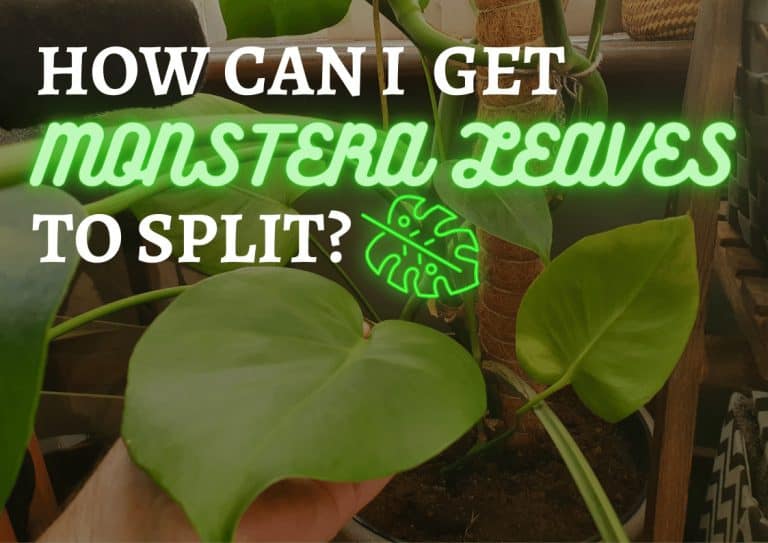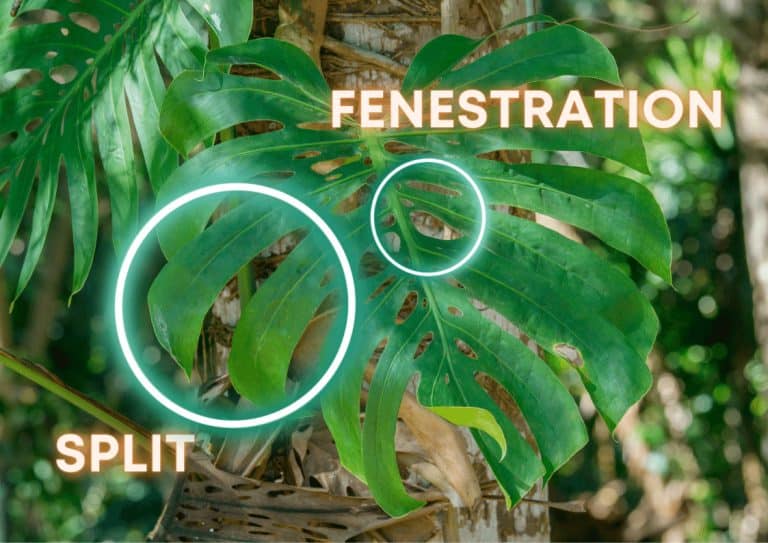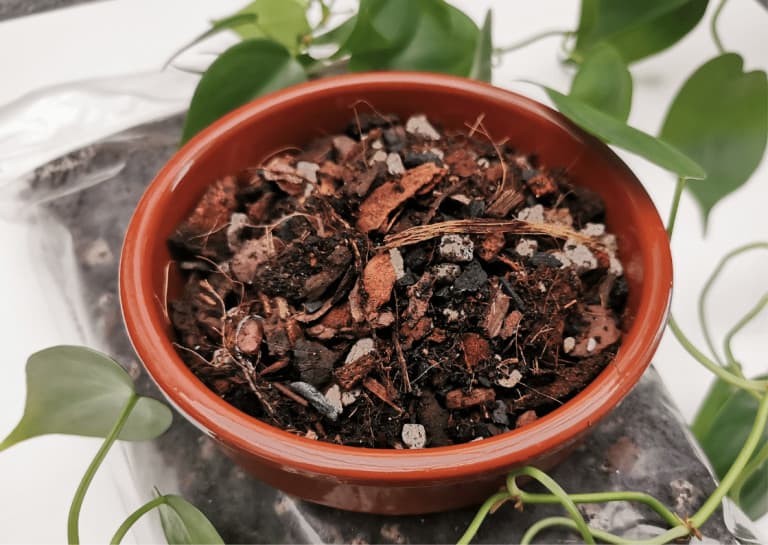Upgrade Your Monstera Game: How to Encourage Leaf Splitting
-
Chris Dosser
- December 17, 2022
If you buy something using the retail links in our articles, sometimes we earn a small affiliate commission. This does not impact the products we recommend.
The distinctive splits and fenestrations seen on Monstera leaves develop in response to a number of factors including species, the age of the plant, genetic profile and growing conditions.
As it’s the most commonly owned Monstera, we’ll use Monstera deliciosa as an example throughout this article to illustrate how you can encourage your plant to grow dramatic leaves full of splits and fenestrations.
We’ll also presume that you are caring for a plant which isn’t in its juvenile stage where solid split free leaves are completely normal.
It’s possible to encourage a mature Monstera deliciosa plant to produce leaves that feature more splits by providing growing conditions that best mimic their natural environment. This means longer exposure to indirect light, increased warmth and a higher humidity.
To help recreate such an environment we’ll cover aspects of plant care including:
- watering habits
- heat
- light exposure
- nutrients
- support structures

Not all Monstera produce split leaves
Firstly it’s important to note that not all of the 59 Monstera species develop splits or fenestrations.
Some Monstera that produce only solid leaves include…
- Monstera dubia
- Monstera standleyan
- Monstera siltepecana
- Monstera peru
And for those that do split, if growing conditions are sub-optimal plants can take months to generate their first decorative leaves, and even longer to incorporate fenestrations.
This is where knowing which species of Monstera you have really comes in handy.
Some species, such as Monstera adonasii, display no splits at all but show fenestrations on all leaves (even newly developed leaves of young plants).
Monstera deliciosa on the other hand produces solid green foliage without splits until the plant has produced at least five leaves. This is completely normal and takes the plant around 4 months.
Splits (the finger like formations around the leaf perimeter) and fenestrations (the holes within leaf blades) are distinctly different however very often folks refer to them both under the same banner of 'splits'.

The signature perforations of a Monstera leaf arise through programmed cell death very early in their development and so once a leaf has unfurled it will not develop any new splits or holes. So to obtain splits we focus on providing the mature plant with conditions that will allow it to grow and produce more leaves.
How to encourage Monstera deliciosa splits to occur
While it is true that your Monstera plant can thrive in a multitude of environments, if you want to see those huge Swiss-cheese style leaves sooner than later, it is best to grow your new plant in conditions that mimic their natural habitat as closely as possible.
Watering habits
Overwatering your plant is one of the biggest mistakes that new Monstera owners make.
Typically, your Monstera will need to be watered every 1-2 weeks when the soil has turned arid (completely dry). You can check your Monstera plant’s soil moisture level by using a soil moisture sensor or simply with your finger.
Optimising humidity also falls under the banner of water management.
Our homes have an average humidity of 30%, which falls more than a little below the humidity experienced by Monstera in their natural environment (60-70%). If possible raise the humidity around the plant itself with regular misting or picking up a humidifier for houseplants.
Our Favorite Monstera Plants And Supplies On Etsy
Heat
Growing a Monstera in a seasonal climate will risk exposing it to low temperatures which it isn’t naturally exposed to in a natural environment. Even indoors.
Sure they are hardy plants and won’t wilt to moderately low temperatures, but the chill will certainly slow the growth of the plant and delay the production of future leaves.
If you wish for the plant to generate leaves with the maximum amount of splits then an optimal temperature range to aim for would be between 65-80ºF (18-27ºC). This might mean moving your plant into a more insulated area of the house during the cold winter months, and away from a poorly insulated porch or grow room.

Light exposure
Monstera deliciosa plants prefer indirect, yet bright, sunlight. Found in the rainforests of Central America it is accustomed to living in an environment where the hot sun is buffered by dense vegetation.
While too much shade will hinder growth, direct sunlight will result in scorched leaves. You have to find a happy medium to ensure the optimum development of your Monstera and aim for a minimum of 8 hours of natural light each day.
We recommend placing your Monstera in view of a north-facing window or behind a sheer, light-filtering curtain.

Nutrition
Your Monstera plant needs adequate nutrition to ensure proper growth and will develop splits fastest in in a soil rich in magnesium, nitrogen, potassium and phosphorus.
Rather than utilize a synthetic fertilizer or a soil additive the best way to provide the root system with what it craves is to pot the plant in a substrate which is ideally made from a mixture of coco husk, pine bark, perlite, biochar and worm casting. Plenty independent retailers on Etsy offer such Monstera mixes.
Support structures
In nature, Monstera plants are epiphytes, meaning they use the trunks of trees to support their growth. Monstera will grow aerial roots to enable them to climb the trees and reach their full potential.
While you may not have a tree handy for your Monstera to cling to for support, you can use a moss pole. Moss or coir poles can aid your Monstera by providing adequate support for the plant, activating the development of aerial roots, supplying additional nutrients and water to the growing plant, and facilitating the growth of more extensive, mature, fenestrated leaves.
Yes, your Monstera can grow without using a moss pole, but if you’re looking to increase the chances of seeing those gorgeous, Swiss-cheese-like leaves at a faster speed, it’s the way to go.
Do Monstera splits develop after leaves have unfurled?
Brand new leaves produced by mature plants will unfurl with inner fenestrations and outer splits already fully formed. If your Monstera plant has produced solid green leaves then these will live out their lives without changing morphologically and will not go on to develop any new splits.
So technically it’s incorrect to ask “when do Monstera leaves split?”, because there is no ‘splitting event’ as they don’t change after being produced.
The signature perforations and splits of a Monstera leaf arise through programmed cell death very early in their development. Once unfurled they will not develop any new splits or holes.
This 2 minute timelapse shows the process of new Monstera deliciosa leaves unfurling in all their glory – note the thin connecting tissue between splits tears when the leaf initially expands to its full size.
Before you go…
The genetic profile of Monstera plants is nothing we can really tinker with and Mother Nature cannot be hurried along, so presuming your plant has been given enough to time to develop at least 5 leaves (the earliest stage at which Monstera deliciosa fenestrations begin to show) the way in which M.deliciosa can be encouraged to produce foliage which includes their stunning architectural splits and holes is to cater as best as possible to its growing needs.
FAQs
If we understand why Monstera evolved to produce fenestrations we’d be able to optimise our man-made growing environments to encourage them to maximise the leaf style we desire.
The problem is that the evolutionary advantage provided to Monstera plants that have holey leaves is still a point of much contention amongst botanists.
Some believe the absence of plant tissue allows the passage of more rainfall to the plant’s root system. However seeing as the plant is epiphytic and uses aerial roots to climbs its way to the canopy this theory doesn’t hold much water (ahem!).
A further theory states that the splits and holes being used to generate turbulence whenever wind passes over the leaf surface, thus cooling the whole plant.
The broken shape of the leaf is even thought by some to have arisen as a means of camouflage to offer protection against herbivores.
The current most accepted hypothesis for why fenestrations have evolved relates to the plant enabling light to pass to lower leaves for energy production purposes, which as a climbing plant present in shady understories makes sense.

Chris Dosser
Co-Founder of Eden Indoors
Chris is a self-taught horticulturist with over a decade of experience caring for houseplants and creating lush, thriving indoor oases. He specializes in Monstera, and by self admission has a serious problem with buying and propagating rare indoor plants!
Similar Posts
Why Are My Monstera Aerial Roots Shriveling?
Should you be worried if the aerial roots on your Monstera starts shriveling up? Does this happen naturally or is it a sign of a poorly plant?
Do All Monstera Species Get Fenestrations As They Age?
Monstera plants are well-known for their beautiful fenestrations, but when do they occur during the plant's development, and do all species develop them?



